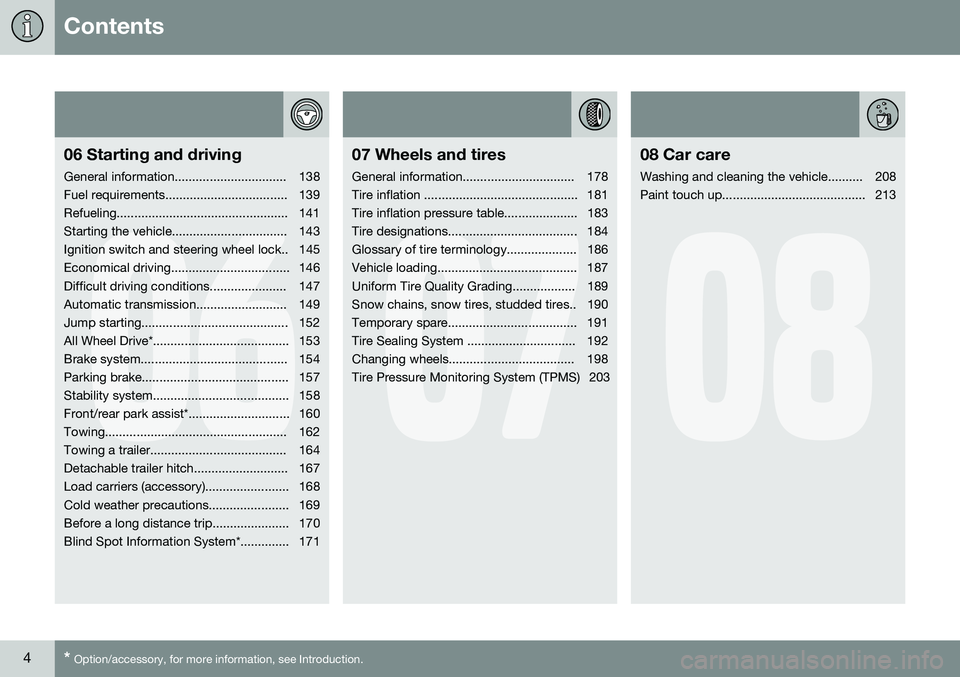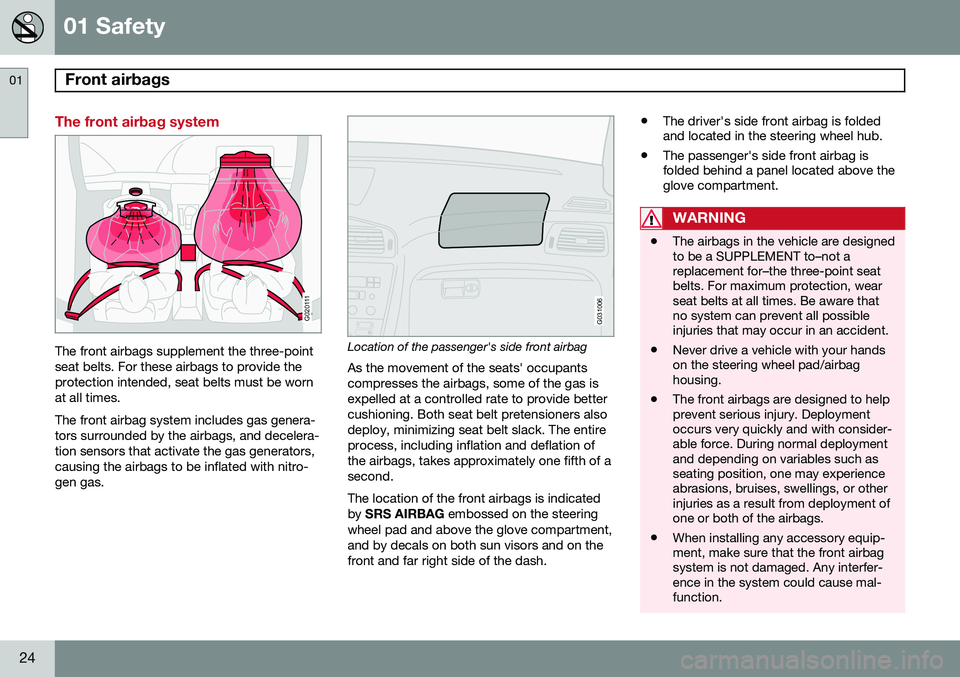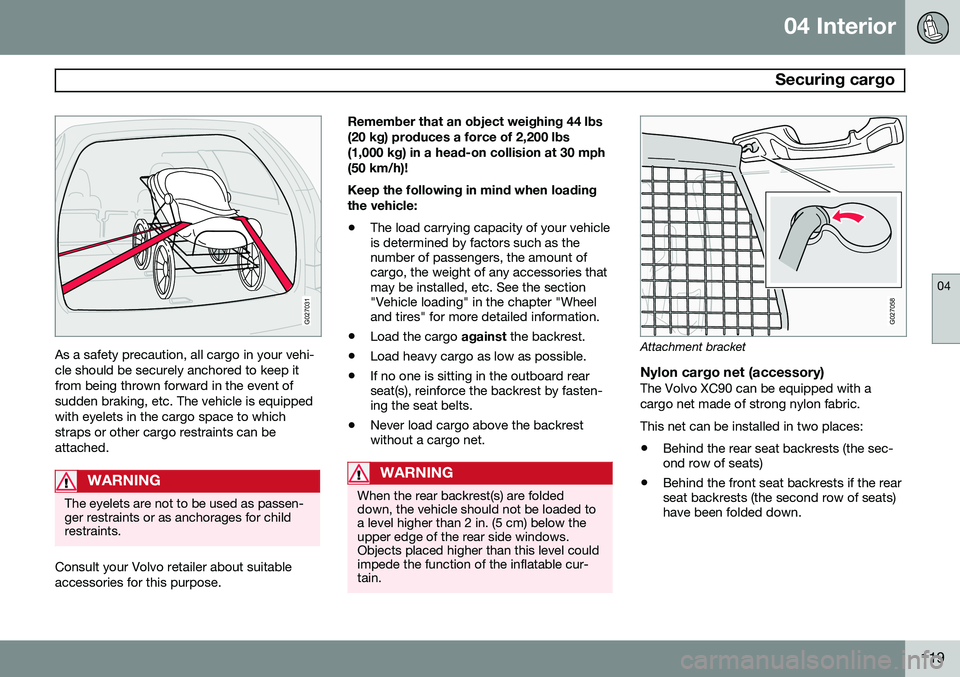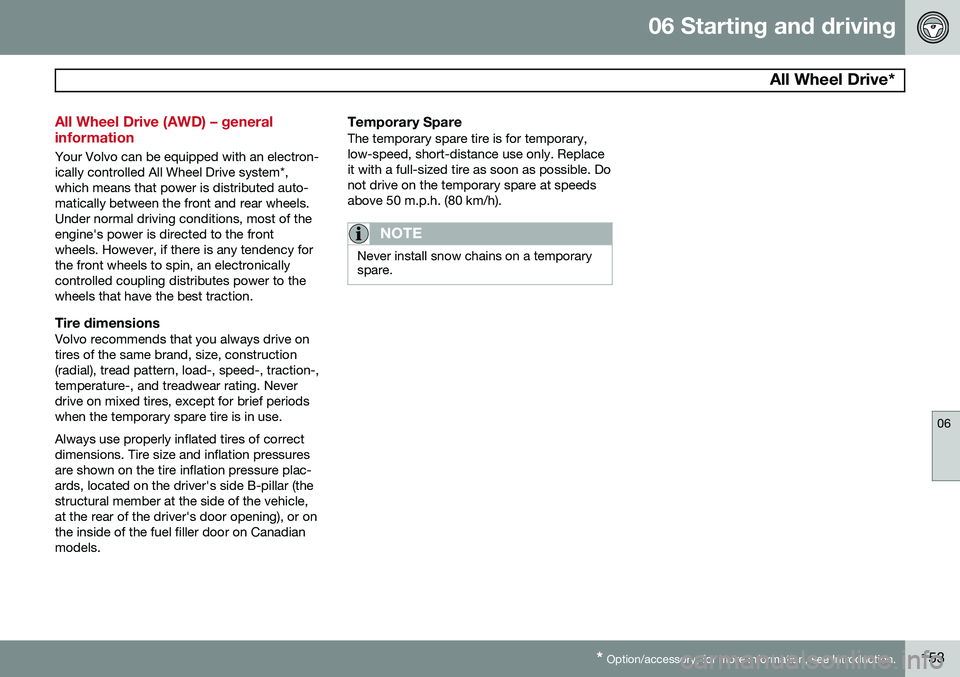flat tire VOLVO XC90 2014 Owner´s Manual
[x] Cancel search | Manufacturer: VOLVO, Model Year: 2014, Model line: XC90, Model: VOLVO XC90 2014Pages: 308, PDF Size: 13.31 MB
Page 6 of 308

Contents
4* Option/accessory, for more information, see Introduction.
06
06 Starting and driving
General information................................ 138
Fuel requirements................................... 139
Refueling................................................. 141
Starting the vehicle................................. 143
Ignition switch and steering wheel lock.. 145
Economical driving.................................. 146
Difficult driving conditions...................... 147
Automatic transmission.......................... 149
Jump starting.......................................... 152
All Wheel Drive*....................................... 153
Brake system.......................................... 154
Parking brake.......................................... 157
Stability system....................................... 158
Front/rear park assist*............................. 160
Towing.................................................... 162
Towing a trailer....................................... 164
Detachable trailer hitch........................... 167
Load carriers (accessory)........................ 168
Cold weather precautions....................... 169
Before a long distance trip...................... 170
Blind Spot Information System*.............. 171
07
07 Wheels and tires
General information................................ 178
Tire inflation ............................................ 181
Tire inflation pressure table..................... 183
Tire designations..................................... 184
Glossary of tire terminology.................... 186
Vehicle loading........................................ 187
Uniform Tire Quality Grading.................. 189
Snow chains, snow tires, studded tires.. 190
Temporary spare..................................... 191
Tire Sealing System ............................... 192
Changing wheels.................................... 198
Tire Pressure Monitoring System (TPMS) 203
08
08 Car care
Washing and cleaning the vehicle.......... 208
Paint touch up......................................... 213
Page 15 of 308

Introduction
Environment
13
Volvo and the environment
Volvo is committed to the well being of its customers. As a natural part of this commit-ment, we care about the environment inwhich we all live. Caring for the environmentmeans an everyday involvement in reducingour environmental impact. Volvo's environ-mental activities are based on a holistic view,which means we consider the overall environ-mental impact of a product throughout itscomplete life cycle. In this context, design,production, product use, and recycling are allimportant considerations. In production,Volvo has partly or completely phased outseveral chemicals including CFCs, lead chro-mates, asbestos, and cadmium; and reducedthe number of chemicals used in ourplants 50% since 1991. Volvo was the first in the world to introduce into production a three-way catalytic con-verter with a Lambda sond, now called theheated oxygen sensor, in 1976. The currentversion of this highly efficient system reducesemissions of harmful substances (CO, HC,NOx) from the exhaust pipe by approximately95 – 99% and the search to eliminate theremaining emissions continues. Volvo is theonly automobile manufacturer to offer CFC-free retrofit kits for the air conditioning systemof all models as far back as the 1975model 240. Advanced electronic engine con-trols and cleaner fuels are bringing us closerto our goal. In addition to continuous environ-mental refinement of conventional gasoline-powered internal combustion engines, Volvois actively looking at advanced technologyalternative-fuel vehicles. When you drive a Volvo, you become our partner in the work to lessen the car's impacton the environment. To reduce your vehicle'senvironmental impact, you can: •
Maintain proper air pressure in your tires. Tests have shown decreased fuel econ-omy with improperly inflated tires.
• Follow the recommended maintenanceschedule in your Warranty and ServiceRecords Information booklet.
• Drive at a constant speed whenever pos-sible.
• See a trained and qualified Volvo servicetechnician as soon as possible forinspection if the check engine (malfunc-tion indicator) light illuminates, or stayson after the vehicle has started.
• Properly dispose of any vehicle-relatedwaste such as used motor oil, used bat-teries, brake pads, etc.
• When cleaning your vehicle, please usegenuine Volvo car care products. AllVolvo car care products are formulated tobe environmentally friendly.
FSC®
The FSC ®
(Forest Stewardship Council ®
)
symbol indicates that the wood pulp used in this publication comes from FSC ®
certified
forests and other responsible sources.
Page 26 of 308

01 Safety
Front airbags 01
24
The front airbag system
G020111
The front airbags supplement the three-point seat belts. For these airbags to provide theprotection intended, seat belts must be wornat all times. The front airbag system includes gas genera- tors surrounded by the airbags, and decelera-tion sensors that activate the gas generators,causing the airbags to be inflated with nitro-gen gas.
G031006
Location of the passenger's side front airbagAs the movement of the seats' occupants compresses the airbags, some of the gas isexpelled at a controlled rate to provide bettercushioning. Both seat belt pretensioners alsodeploy, minimizing seat belt slack. The entireprocess, including inflation and deflation ofthe airbags, takes approximately one fifth of asecond. The location of the front airbags is indicated by SRS AIRBAG embossed on the steering
wheel pad and above the glove compartment,and by decals on both sun visors and on thefront and far right side of the dash. •
The driver's side front airbag is folded and located in the steering wheel hub.
• The passenger's side front airbag isfolded behind a panel located above theglove compartment.
WARNING
• The airbags in the vehicle are designed to be a SUPPLEMENT to–not areplacement for–the three-point seatbelts. For maximum protection, wearseat belts at all times. Be aware thatno system can prevent all possibleinjuries that may occur in an accident.
• Never drive a vehicle with your handson the steering wheel pad/airbaghousing.
• The front airbags are designed to helpprevent serious injury. Deploymentoccurs very quickly and with consider-able force. During normal deploymentand depending on variables such asseating position, one may experienceabrasions, bruises, swellings, or otherinjuries as a result from deployment ofone or both of the airbags.
• When installing any accessory equip-ment, make sure that the front airbagsystem is not damaged. Any interfer-ence in the system could cause mal-function.
Page 121 of 308

04 Interior
Securing cargo
04
119
G027031
As a safety precaution, all cargo in your vehi- cle should be securely anchored to keep itfrom being thrown forward in the event ofsudden braking, etc. The vehicle is equippedwith eyelets in the cargo space to whichstraps or other cargo restraints can beattached.
WARNING
The eyelets are not to be used as passen- ger restraints or as anchorages for childrestraints.
Consult your Volvo retailer about suitable accessories for this purpose.Remember that an object weighing 44 lbs(20 kg) produces a force of 2,200 lbs(1,000 kg) in a head-on collision at 30 mph(50 km/h)! Keep the following in mind when loading the vehicle:
• The load carrying capacity of your vehicle is determined by factors such as thenumber of passengers, the amount ofcargo, the weight of any accessories thatmay be installed, etc. See the section"Vehicle loading" in the chapter "Wheeland tires" for more detailed information.
• Load the cargo
against the backrest.
• Load heavy cargo as low as possible.
• If no one is sitting in the outboard rearseat(s), reinforce the backrest by fasten-ing the seat belts.
• Never load cargo above the backrestwithout a cargo net.
WARNING
When the rear backrest(s) are folded down, the vehicle should not be loaded toa level higher than 2 in. (5 cm) below theupper edge of the rear side windows.Objects placed higher than this level couldimpede the function of the inflatable cur-tain.
G027058
Attachment bracket
Nylon cargo net (accessory)The Volvo XC90 can be equipped with a cargo net made of strong nylon fabric. This net can be installed in two places:
• Behind the rear seat backrests (the sec- ond row of seats)
• Behind the front seat backrests if the rearseat backrests (the second row of seats)have been folded down.
Page 142 of 308

06 Starting and driving
Fuel requirements
06
140
WARNING
Driving with the tailgate open: Driving
with the tailgate open could lead to poi- sonous exhaust gases entering the pas-senger compartment.
• If the tailgate must be kept open for any reason, proceed as follows:
• Close the windows
• Set the ventilation system control to airflow to floor, windshield and side win-dows and blower control to its highestsetting.
Gasoline containing alcohol and ethers, "Oxygenated fuels"
Some fuel suppliers sell gasoline containing "oxygenates" which are usually alcohols orethers. In some areas, state or local lawsrequire that the service pump be marked indi-cating use of alcohols or ethers. However,there are areas in which the pumps areunmarked. If you are not sure whether there isalcohol or ethers in the gasoline you buy,check with the service station operator. Tomeet seasonal air quality standards, someareas require the use of "oxygenated" fuel. Volvo allows the use of the following "oxy- genated" fuels; however, the octane ratingslisted on page 139 must still be met.
Alcohol – EthanolFuels containing up to 10% ethanol by vol- ume may be used. Ethanol may also be refer-red to as Ethyl alcohol, or "Gasohol". Ethers – MTBE: Fuels containing up to 15% MTBE may be used.
MethanolDo not use gasolines containing methanol(methyl alcohol, wood alcohol). This practicecan result in vehicle performance deteriora-tion and can damage critical parts in the fuelsystem. Such damage may not be coveredunder the New Vehicle Limited Warranty.
Weight distribution affects handlingAt the specified curb weight your vehicle hasa tendency to understeer, which means thatthe steering wheel has to be turned morethan might seem appropriate for the curva-ture of a bend. This ensures good stability and reduces the risk of rear wheel skid. Remember that theseproperties can alter with the vehicle load. The heavier the load in the cargo area, the less the tendency to understeer.
Handling, roadholdingVehicle load, tire design and inflation pres-sure all affect vehicle handling. Therefore,check that the tires are inflated to the recom- mended pressure according to the vehicleload. See "Tire pressure" section. Loads should be distributed so that capacity weight or maximum permissible axle loadsare not exceeded.
Conserving electrical currentKeep the following in mind to help minimizebattery drain:
• When the engine is not running, avoid turning the ignition key to position
II (see
page 145). Many electrical systems (theaudio system, the optional infotainment/navigation systems, power windows, etc)will function with the ignition key in posi-tion I. This position reduces drain on the
battery.
• Please keep in mind that using systems,accessories, etc that consume a greatdeal of current when the engine is notrunning could result in the battery beingcompletely drained. Driving or having theengine running for approximately15 minutes will help keep the batterycharged.
NOTE
A warning message will be displayed in the text window in the instrument panel whenthe battery charge is low.
Page 155 of 308

06 Starting and driving
All Wheel Drive*
06
* Option/accessory, for more information, see Introduction.153
All Wheel Drive (AWD) – general information
Your Volvo can be equipped with an electron- ically controlled All Wheel Drive system*,which means that power is distributed auto-matically between the front and rear wheels.Under normal driving conditions, most of theengine's power is directed to the frontwheels. However, if there is any tendency forthe front wheels to spin, an electronicallycontrolled coupling distributes power to thewheels that have the best traction.
Tire dimensionsVolvo recommends that you always drive ontires of the same brand, size, construction(radial), tread pattern, load-, speed-, traction-,temperature-, and treadwear rating. Neverdrive on mixed tires, except for brief periodswhen the temporary spare tire is in use. Always use properly inflated tires of correct dimensions. Tire size and inflation pressuresare shown on the tire inflation pressure plac-ards, located on the driver's side B-pillar (thestructural member at the side of the vehicle,at the rear of the driver's door opening), or onthe inside of the fuel filler door on Canadianmodels.
Temporary SpareThe temporary spare tire is for temporary,low-speed, short-distance use only. Replaceit with a full-sized tire as soon as possible. Donot drive on the temporary spare at speedsabove 50 m.p.h. (80 km/h).
NOTE
Never install snow chains on a temporary spare.
Page 164 of 308

06 Starting and driving
Towing
06
162
G027042
Positions for attaching towing eyelets
Emergency towingThe towing eyelet is located in the tool bag, under the floor of the cargo area. This eyeletmust be screwed into the positions providedon the right sides of either the front or rearbumper (see illustrations).
To attach the towing eyelet:1. Use a coin to pry open the lower edge ofthe cover (A)
2. Screw the towing eyelet (C) in place (B), first by hand and then using the tire ironuntil it is securely in place. After the vehicle has been towed, the eyeletshould be removed and returned to the toolbag. Press the cover back into position.
WARNING
Do not use the towing eyelets to pull the vehicle up onto a flat bed tow truck.
Precautions when the vehicle is in tow
•
The steering wheel must be unlocked. Turn the ignition key to position
I or II.
• The gear selector must be in position
N. •
Maximum speed: 50 mph (80 km/h). Donot exceed the maximum allowable tow-ing speed.
• Maximum distance with front wheels onground: 50 miles (80 km).
• While the vehicle is being towed, try tokeep the tow rope taut at all times.
• The vehicle should only be towed in theforward direction.
Page 167 of 308

06 Starting and driving
Towing a trailer
06
165
Points to keep in mind when towing a trailer
•When towing trailers
without brakes, the
maximum permissible trailer weight is 1,700 lbs (750 kg).
• If necessary, redistribute the weight ofany cargo in the trailer to avoid excessiveweight on the trailer hitch.
• The maximum trailer weight listed in thetable for All Wheel Drive models,5,000 lbs (2250 kg) is only applicablewhen there are not more than two occu-pants in the vehicle, in the front seats,with a combined weight of 300 lbs(135 kg), with no other cargo in the vehi-cle.
• The maximum weight listed for FrontWheel Drive models, 4,000 lbs (1800 kg)is only applicable when there are notmore than four occupants in the vehicle,in the front seats and second row ofseats, with a combined weight of 600 lbs(270 kg), with no other cargo in the vehi-cle.
• Vehicles used for towing a trailer on aregular basis, or for long-distance high-way towing should be equipped with anautomatic transmission oil cooler andVolvo's automatic self-leveling system forthe rear suspension. Consult your Volvoretailer. •
Volvo recommends the use of Volvotrailer hitches that are specially designedfor the vehicle.
• All Volvo models are equipped withenergy-absorbing shock-mounted bump-ers. Trailer hitch installation should notinterfere with the proper operation of thisbumper system.
• Increase tire pressure to recommendedfull inflation pressure. See chapter"Wheels and tires."
• When your vehicle is new, avoid towingheavy trailers during the first 620 miles(1,000 km).
• Engine and transmission are subject toincreased loads. Therefore, engine cool-ant temperature should be closelywatched when driving in hot climates orhilly terrain. Use a lower gear and turn offthe air conditioner if the temperaturegauge needle enters the red range.
• If the automatic transmission begins tooverheat, a message will be displayed inthe text window.
• Hauling a trailer affects handling, durabil-ity, and economy.
• It is necessary to balance trailer brakeswith the towing vehicle brakes to providea safe stop (check and observe state/local regulations). •
Do not connect the trailer's brake systemdirectly to the vehicle's brake system.
• Remove the ball and drawbar assemblywhen the hitch is not being used.
• Volvo recommends the use of syntheticengine oil when towing a trailer over longdistances or in mountainous areas.
NOTE
•When parking the vehicle with a trailer on a hill, apply the parking brakebefore putting the gear selector in
P.
When starting on a hill, put the gearselector in D before releasing the park-
ing brake. Always follow the trailermanufacturer's recommendations forwheel chocking.
• If you use the manual (Geartronic) shiftpositions while towing a trailer, makesure the gear you select does not puttoo much strain on the engine (usingtoo high a gear).
Page 178 of 308

176
General information............................................................................... 178 Tire inflation .......................................................................................... 181
Tire inflation pressure table................................................................... 183
Tire designations...................................................................................184
Glossary of tire terminology.................................................................. 186Vehicle loading...................................................................................... 187
Uniform Tire Quality Grading................................................................ 189
Snow chains, snow tires, studded tires................................................ 190
Temporary spare................................................................................... 191
Tire Sealing System ............................................................................. 192
Changing wheels................................................................................... 198
Tire Pressure Monitoring System (TPMS)............................................. 203
Page 180 of 308

07 Wheels and tires
General information
07
178
Introduction
Your vehicle is equipped with tires according to the vehicle's tire information placard on theB-pillar (the structural member at the side ofthe vehicle, at the rear of the driver's dooropening).
CAUTION
Some Volvo models are equipped with an Ultra High Performance tire and wheelcombination designed to provide maxi-mum dry pavement performance with con-sideration for hydroplaning resistance.They may be more susceptible to roadhazard damage and, depending on drivingconditions, may achieve a tread life of lessthan 20,000 miles (30,000 km). Even if thisvehicle is equipped with Volvo’s advancedAWD or DSTC system, these tires are notdesigned for winter driving, and should bereplaced with winter tires when weatherconditions dictate.
The tires have good road holding characteris- tics and offer good handling on dry and wetsurfaces. It should be noted however that thetires have been developed to give these fea-tures on snow/ice-free surfaces. Most models are equipped with "all-season" tires, which provide a somewhat higherdegree of road holding on slippery surfacesthan tires without the "all-season" rating.However, for optimum road holding on icy orsnow-covered roads, we recommend suitablewinter tires on all four wheels. When replacing tires, be sure that the new tires are the same size designation, type(radial) and preferably from the same manu-facturer, on all four wheels. Otherwise there isa risk of altering the car's roadholding andhandling characteristics.
New Tires
Remember that tires are perishable goods. Asof 2000, the manufacturing week and year(Department of Transportation (DOT) stamp)will be indicated with 4 digits (e.g., 1513means that the tire illustrated was manufac-tured during week 15 of 2013).
Tire rotationYour vehicle has no required tire rotation. Tire wear is affected by a number of factors suchas tire inflation, ambient temperature, drivingstyle, etc.
NOTE
•
If the tires are rotated, they should only be moved from front to rear orvice versa. They should never be rota-ted left to right/right to left.
• Ideally, tire rotation should be done thefirst time after approximately 3,000miles (5,000 km) and thereafter at6,000-mile (10,000-km) intervals.Some customers find that tire rotationmay help to get extra mileage from tirelife.
• Tire rotation should only be performedif front/rear tire wear is fairly even andtread height is above 1/16" (1.6 mm).
Your Volvo retailer can also provide guidance based on your particular driving circumstan-ces.
Tire ageTires degrade over time, even when they arenot being used. It is recommended that tiresgenerally be replaced after 6 years of normalservice. Heat caused by hot climates, fre-